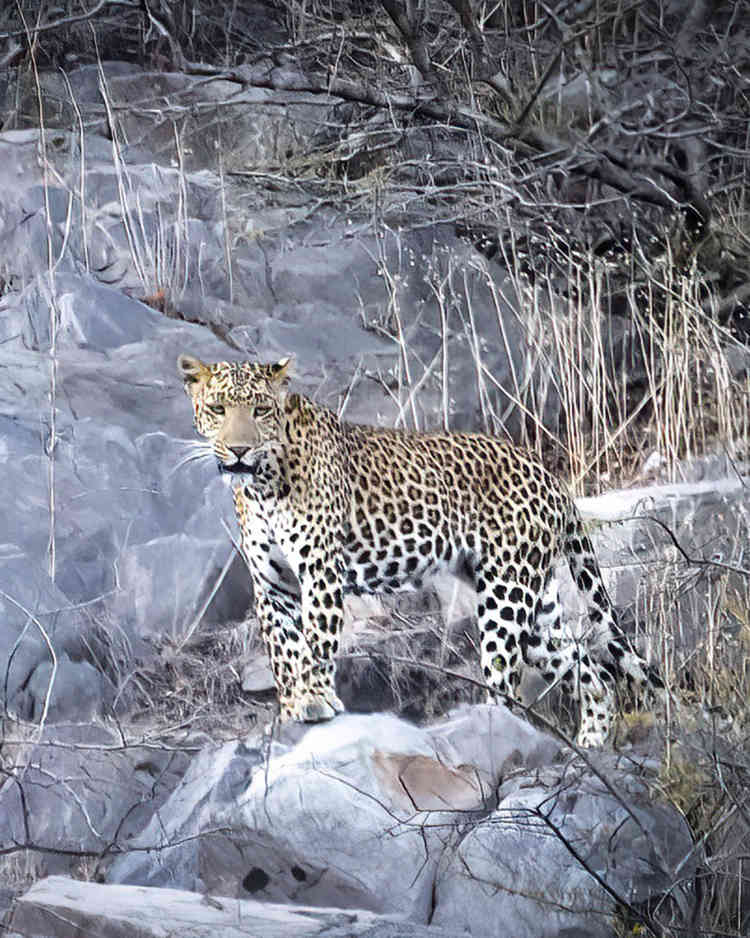We are sitting in an open safari jeep waiting to spot leopards on the Aravali range of the Jhalana Leopard Park. Spread over 22 sq km in the middle of the urban sprawl of Pink City–Jaipur, tall buildings and the sound of traffic crowd the periphery of the park.
Somewhere around the bushes and tall rocks near us, the leopards were listening and watching too. And then we saw the 'Prince of Jhalana', an orange-gold leopard poised on a rock about 30 feet above us. Its head was thrust attentively towards the direction of the ravine. It must have sensed our presence as it slowly turned its head to look down at us. Puzzled at our presence, it sprang away into the thicket, making no sound as it melted into the shadows.
A forest official told us that there are approximately 35 leopards, including offspring, which means a habitat of less than one sq km per animal. Leopards can easily traverse 10-15 km in a day. The leopard population of Jhalana has thrived despite continuous disturbance and anthropogenic activities outside and within the forest.
After the tiger conservation success story in India reported earlier, we now have good news about Indian leopards. In December, the Ministry of Environment, Forest and Climate Change announced the increase in the leopard population by nearly 60 per cent in four years. India is now home to 12,852 leopards as of 2018, while it hosted around 7,910 in 2014.
According to the report, 'Status of Leopards in India, 2018', released by Union Environment Minister Prakash Javadekar on December 21, 2020, the increase in tiger, lion and leopard numbers over the last few years is a testimony to relentless conservation efforts. The report says that monitoring of the tiger has clearly shown its umbrella role in the ecosystem, which has shed light on other charismatic species like the leopard.
The report also rings warning bells. It points out that while the estimated number of leopards has increased, leopard habitat area has been shrinking alarmingly over the past 100-125 years. It concludes that while genetic and population data suggest leopard population is continuous, there is an increasing need for corridor connectivity and improvement of habitat to reduce interface with humans, thereby reducing the chance of conflict.
Experts say the number of leopards is likely to be much higher than the current estimation. The study has been conducted only in tiger-populated forests areas under Project Tiger, and leopard populations in agricultural areas have not been considered. The estimation exercise has also not considered leopard occupied areas such as non-forested habitats (coffee and tea plantations), higher elevations in the Himalayas, arid landscapes and the North-Eastern landscape.
A major concern is that leopard habitat has reduced over 125 years. The leopards are listed under the International Union for Conservation of Nature (IUCN) Red List as the ‘Near Threatened’ species.
The leopard (Panthera pardus) is one of the most widely distributed felids across the Indian subcontinent. It is one of four big cats, besides the tiger, snow leopard, and the clouded leopard. This spotted cat, with its short powerful limbs, heavy torso, and large black spots grouped into rosettes, is a solitary creature that is almost nocturnal.
Unlike other big cats, they are adaptive by nature. They can prey, for example, on anything from mice and porcupines to monkeys and dogs. They can thrive in deep forests and near human settlements. That adaptability, combined with a genius for hiding in plain sight, means leopards are capable of living alongside humans.
In the last few years, we have seen CCTV footage of leopards slipping through streets in rural and urban India to pick off dogs, cats, goats, pigs etc. The leopard doesn’t avoid coming into areas inhabited by human beings but avoids detection. Leopards come into human-dominated areas for ‘easy and abundant’ prey but are fearful of people.
Humans make fickle companions, admiring, rescuing, and even revering leopards in some contexts, but also hunting, snaring, poisoning, hanging them. There was an incident of people dousing a trapped leopard with kerosene and setting it on fire, calmly filming as the animal writhes and dies in a ball of fire, but not nearly fast enough.
Conservationists call leopards the world’s most persecuted big cat. More than 2,000 leopards have been killed in India since 2014. The conflict between humans and leopards is causing collateral damage where northern Indian states have become the epicentre. Leopard attacks on humans are mostly accidental and loss of human life are rare.
A survey by the Wildlife Institute of India says there are more than 40-45 leopards in the Delhi-NCR region which falls in the Aravallis. Last year, 35 leopards were spotted in Gurgaon and nearby areas, testimony to human interference in their habitat—illegal mining and rampant construction. City forest officials are now holding camps in villages on how to deal with leopards, who have a long history of co-existence with people.
People also tend to kill leopards for fear of losing their lives. Leopards have been hit by cars or trucks while crossing roads.
Blaming lack of public awareness, Koustubh Sharma, an ecologist, says there were many examples from across the country where leopards are living peacefully with humans—Mumbai, Jawai and Shimla. The truth is that India is urbanising rapidly along with rise in population. Leopards near towns or villages are not strays: these are areas where they have a long history.
The question is can co-habitation work and till how long?




















